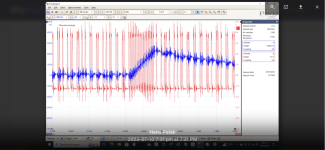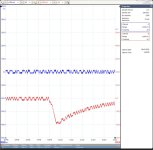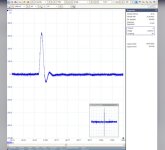I couldn’t fault the USB power either. If it didn’t sound good I would have tried this separate supply arrangement but what came out froze me to enjoy the details of music. Maybe separating power will be even better, will see next time🙂
Hi Mark,Not faulting Amanero. Faulting USB power.
The issue that Marcel described, the randomly generated of series of 16 ones in one channel, but not in the second channels, when this would have been a USB power problem, why did it occur at DSD512 only and not at lower bitrates.
To me that makes little sense, apart from the fact that the Amanero only uses the 5Volt USB power to generate its own 3.3Volt power supply.
Also the test with a short and a long USB cable did not change anything to the erroneous channel behaviour, just another possible sign that the USB power was not just on the edge.
But the spikes that where generated had a ca. 10usec duration at the Dac’s output, and I’m not sure if anybody can hear that.
At least I didn’t try, since my goal was measuring only.
Since I had no intention going to use this Amanero in future, but just needed it for testing out of curiosity how the shiftregister Dac performed compared to Marcel’s solid state Dac, I bought an affordable one from eBay that hadn’t been used. But I have no idea where this person originally got it.
As mentioned in my review, Marcel’s shifregister Dac performed flawless at all DSD multiples but having had the opportunity to test it with separated clock and data lines over short coax connections, would most likely have shown better S/N figures at higher DSD rates.
Last thing worth mentioning is that test results are not telling the perceived level of audio reproduction.
So the Amanero may sound very fine, but at least my Amanero had technical flaws with crosstalk and anomalies in one channel at DSD512, but a listening test might not have revealed that.
Hans
It has spectral content at low frequencies, so it should be audible when it is played back loud enough. It's rather similar to click noise in FM radio, when the reception is poor.
Hi Hans,
I'm sorry. Didn't mean to imply the problem you saw was because of USB power. Hard to say without more testing.
It just seemed to me that the discussion with Acko had moved on to include the use of Amanero more generally.
I was puzzled by the apparent satisfaction with it when powered from USB. IME the same would be true for other USB boards if powered that way.
That said, noise on USB power is likely to be different in every case since it is dependent on the particular computer.
Mark
I'm sorry. Didn't mean to imply the problem you saw was because of USB power. Hard to say without more testing.
It just seemed to me that the discussion with Acko had moved on to include the use of Amanero more generally.
I was puzzled by the apparent satisfaction with it when powered from USB. IME the same would be true for other USB boards if powered that way.
That said, noise on USB power is likely to be different in every case since it is dependent on the particular computer.
Mark
Mark,
When I’m back from holiday, I will test the 5Volt USB supply straight on the Amanero while receiving DoP512, that will give us a better insight.
Oops I’m afraid I used another non existing term 🤣
Hans
When I’m back from holiday, I will test the 5Volt USB supply straight on the Amanero while receiving DoP512, that will give us a better insight.
Oops I’m afraid I used another non existing term 🤣
Hans
Doesn't DoP have an upper limit of DSD256? I don't use it but seem to recall that, or perhaps that has been extended by current hardware capabilities?
From https://amanero.com/drivers/combo384-D3.pdf

So DoP in Amanero is max DSD128...
From https://dsd-guide.com/dop-open-standard
DSD128 it's 1 bit 6.144MHz, this is equivalent to PCM 16 bit at 384kHz.
384kHz it's max for PCM Amanero.
So DoP in Amanero is max DSD128...
From https://dsd-guide.com/dop-open-standard
DSD128 it's 1 bit 6.144MHz, this is equivalent to PCM 16 bit at 384kHz.
384kHz it's max for PCM Amanero.
So if I understand it correctly, the Asio driver does not use DoP but some other technique to get the data through the USB interface at a DSD256 or DSD512 rate. OK.
In any case, the raw DSD output interface is supposed to work properly up to and including DSD512 when the Asio driver is used, but in Hans's case, for whatever reason, it produced randomly spaced strings of 16 ones in one channel.
In any case, the raw DSD output interface is supposed to work properly up to and including DSD512 when the Asio driver is used, but in Hans's case, for whatever reason, it produced randomly spaced strings of 16 ones in one channel.
Asio driver does not use DoP but some other technique to get the data through the USB interface at a DSD256 or DSD512 rate.
It's Native DSD.
To get it working I had to tell JR to use bitstream DSD which means packing DSD into DoP
It took me some time to find out, but after that the DSDON signal went high and everything worked.
With DSD256 both channels but with DSD512 one channel with random series of 16 “ones” resulting in 10 usec spikes at the filter output.
Hans
It took me some time to find out, but after that the DSDON signal went high and everything worked.
With DSD256 both channels but with DSD512 one channel with random series of 16 “ones” resulting in 10 usec spikes at the filter output.
Hans
Sending DoP at DSD512 could be a problem. The internal bit rate might have to be 45/49MHz, which is twice the frequency of Amanero master clocks.
Also, that Amanero only supports DSD512 using ASIO drivers would seem to imply it must be Native DSD format.
Also, that Amanero only supports DSD512 using ASIO drivers would seem to imply it must be Native DSD format.
Last edited:
To get it working I had to tell JR to use bitstream DSD which means packing DSD into DoP
How do you know that is what it means? What choices were there besides bitstream DSD?
I’m on vacation, there were 6 different non DSD options but I have no acces to my system from here.
Lucky me 😎
Hans
Lucky me 😎
Hans
Quoting the document you linked to:
"For ASIO Devices, you need to enable DSD bitstream in DoP Format in Tools > Options > Audio > Audio Device > Device Settings, otherwise native ASIO DSD bitstreaming will be used."
Apparently bitstream DSD means DoP when you use a WASAPI driver, but by default native ASIO DSD bitstreaming is used with an ASIO 2.2 driver.
"For ASIO Devices, you need to enable DSD bitstream in DoP Format in Tools > Options > Audio > Audio Device > Device Settings, otherwise native ASIO DSD bitstreaming will be used."
Apparently bitstream DSD means DoP when you use a WASAPI driver, but by default native ASIO DSD bitstreaming is used with an ASIO 2.2 driver.
Last edited:
I used the specific Asio driver supplied by Amanero and enabled the DSD bitstream in DoP format.
Amanero also supplies a Wasapi driver, that one only works for DSD64 and DSD128.
For both Amanero drivers the DSD bitstreaming option had to be enabled.
Hans
Amanero also supplies a Wasapi driver, that one only works for DSD64 and DSD128.
For both Amanero drivers the DSD bitstreaming option had to be enabled.
Hans
One could always use the trial version of HQ Player. It will run for 30-minutes at a time.
Its that when having problems like this, usually substitution is quickest way to figure out where the problem is. A scope to check the USB board output if often helpful as well.
Its that when having problems like this, usually substitution is quickest way to figure out where the problem is. A scope to check the USB board output if often helpful as well.
First image is the Amanero output in red and the Firdac’s output in blue before the analogue filter.
Second image is a more accuratr image of left and right channel again after the Firdac and before the analogue filter.
One channel is O.K. and the other is showing a spike, this time in negative direction.
Third image shows how a spike looks after being analogue filtered.
Hans
Second image is a more accuratr image of left and right channel again after the Firdac and before the analogue filter.
One channel is O.K. and the other is showing a spike, this time in negative direction.
Third image shows how a spike looks after being analogue filtered.
Hans
Attachments
Is the underlying issue here the DSD-on flag that is being output - Marcel's RTZ DAC has 0ohm jumpers that need to be correctly configured (for mute too). I suggest setting the Amanero to use ASIO non-DoP bitstreaming with a native DSD source and check the if the DSD-on flag at the output of the Amanero is hi or lo and then reconcile that to the jumper settings on the DAC. Just wondering, apologies if this has already been addressed.
- Home
- Source & Line
- Digital Line Level
- Return-to-zero shift register FIRDAC


